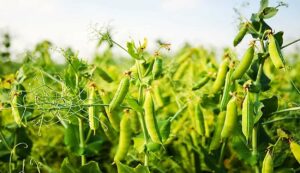Rust disease is very harmful for pea crops; know its management
Management of Pea Rust: The fungus Uromyces pisi is the source of pea rust, a significant disease that affects pea crops all over the globe. On undamaged sections of the pea plant, particularly on the leaf surface, pea rust produces distinctive blister-like structures that range in color from light yellow to dark yellow, reddish-brown, and first discharge light yellow powdery pustules before turning dark yellow, red, and lastly brown or black. Pea rust threatens pea crops by reducing their quality and output. Implementing successful management requires an understanding of its biology, life cycle, and environmental needs.

Epidemiology and Disease Cycle
Pea rust has both sexual and asexual phases in its life cycle. The pathogen causes primary infection in the spring after overwintering as teliospores in infected plant debris. The growth season produces urediniospores, which are asexual spores that contribute to secondary infections. Comprehending these phases facilitates prompt managerial actions.
Resistance from the Host
One ecologically responsible and sustainable way to control pea rust disease is to breed resistant pea cultivars. To increase a variety’s resistance to the virus, researchers work to find resistance genes and incorporate them into the variety. This approach lessens reliance on chemical treatments.
Control of Chemicals
In the control of pea rust, fungicides are crucial, particularly in situations when the environment is conducive to the growth of the disease. Applying fungicides on time lowers crop losses and stops the infection from spreading. Overuse of chemicals, however, raises questions about the effects on the environment and the emergence of resistant strains. In order to treat this condition, propiconazole at a rate of 1 milliliter per liter of water must be sprayed as soon as symptoms start to show. By spraying twice at ten-day intervals, this disease may be stopped from spreading. However, it should be noted that the spraying should be done at least ten days prior to the pea pods being harvested.
Agriculture (Cultural) Approach
Effective agricultural practices can make a big difference in pea rust control. Cultural (agricultural) practices that disrupt the disease cycle include crop rotation, sanitation, and planting resistant cultivars. The likelihood of infection is decreased by removing diseased plant detritus and planting at the right distance to improve air circulation.
IDM stands for Integrated Disease Management
The foundation of integrated illness management is the coordinated combination of different approaches. IDM for pea rust is a comprehensive strategy that incorporates cultural practices, host resistance, and the prudent use of fungicides. This all-encompassing approach promotes sustainable and efficient disease control by reducing reliance on a single technique.
Monitoring and Early Identification
Frequent field inspections are necessary to identify pea rust early. Monitoring aids in determining the severity of the condition and the best time to intervene. Early diagnosis lessens the need for overuse of fungicides by enabling more focused and effective management techniques.
Environmental Aspects
Effective control of pea rust depends on an understanding of how environmental conditions affect its growth. Temperature, humidity, and moisture all have a big impact on how severe an illness is. The precision and effectiveness of management plans may be improved by putting control measures into action based on weather predictions.
Obstacles and Potential Paths
Even with advancements in pea rust control, difficulties still exist. Further study is necessary to understand how environmental changes impact disease dynamics and how emerging pathogen strains are becoming more resistant to fungicides. Innovative breeding methods, sustainable management strategies, and international cooperation to tackle new issues should be the main focuses of future directions.





